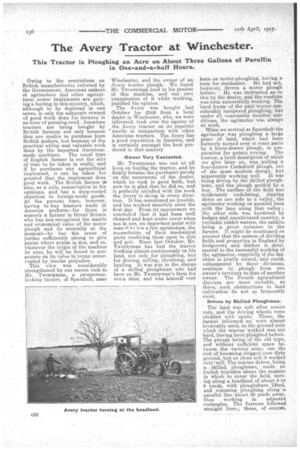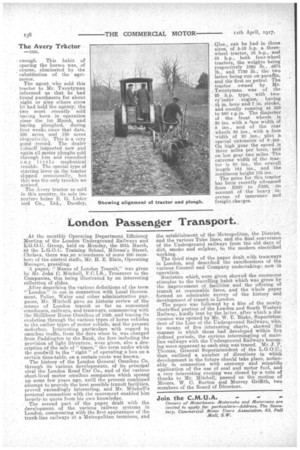The Avery Tractor at Winchester,
Page 8

Page 9

Page 10

If you've noticed an error in this article please click here to report it so we can fix it.
This 'Tractor is Ploughing an Acre on About Three Gallons of Paraffin in One-and-a-half Hours.
Owing to the restrictions on British manufacturers enforced by. the Government, American makers of agiamotors and other agricultural motor implements are gaining a footing in this country, which, although to be deplored in one sense, is only the adequate reward of good work done for farmers in an hour of pressing need. American tractors are being bought by BritiSh farmers not only because they are unable to purchase from British makers, but because of the practical utility and valuable work done by the imported Americanmade machines. The usual type of English farmer is not the sort of man to be taken in easily, and if he purchases any agricultural implement, it can be taken for granted that the implement does good work. The British farmer also, as a rule, conservative in his opinions, and has a deep-rooted objection to foreign-made goods. At the present time, however, having to buy tractors made in America perforce—for there is scarcely a farmer in Great Britain who has not. recognized the merits and economical value of the motor plough and its necessity at the moment—he has the sense of justice sufficiently strong to give praise where praise is due, and so, whatever the origin of the machine he uses, he will be found to pronounce on its value intarms uncorrupted by insular prejudice. . This view was considerably strengthened by our recent visit to Mr. Twentyman,. a prosperous looking farmer, of Sparsholt, near Winchester, and the owner of an. Avery tractor ,plough. We found Mr. Twentyman loud in his praises of this machine, and our, owe examination of it while .working, justified his opinion. The Avery was bought last October for 2500, from a local dealer in Winchester, who, we were informed, took over the agency of the Avery tractor on its superior merits in comparison with other American tractors. The Avery has a good reputation in America, and is certainly amongst the best produced in that country Owner Very Contented.
Twentyman was not at all keen on buying the tractor, and he finally became the purchaser purely on the assurances of the dealer, which he took in good faith, but now he is glad that he did so, and is perfectly satisfied with the work the Avery is doing in every direction. It has occasioned no trouble, and has worked smoothly since the first day. Prom its appearance we concluded that it had been well cleaned and kept under cover when not in use, an important point with rega-rl to net a few agrimotors, the aouessibility of thoumechanical parts rendering them open to dirt and grit. Since last October, Mr. Twentyman has had the tractor working almost continuously on his land, not only for ploughing, but for discing, rolling, threshing, and hauling,. It was put in the charge of a skilled ploughman who had been on Mr. Twentyma,n's farm for smile time, and was himself • very
keen on motor-ploughing, having a turn for mechanics. he had not, however, 'driven a motor plough before. He was instructed as to this by the dealer, and the machine was soon successfully working. The hard frosts of the past winter considerably hampered ploughing, but under all reasonable weather conditions, the agrimotor' was always at work.
When we arrived at Sparsholt the agrimotor was ploughing a large piece • of land, which had been formerly turned over in some parts by a horse-drawn plough, in preparation for potato sowing. The tractor, a brief description of which we give later on was pulling a four-furrow. Cockshutt plough, not of the mo.st modern design, but apparently working well. It was being driven by the skilled ploughman, and the plough guided by a boy. The surface of the field was moderately undulating, dipping down on one side to a valley, the agrimotor working on parallel lines with the lane along that valley ; -the .other side was bordered by hedges and uncultivated country, a veritable rabbit warren, the rabbits being a great nuisance to the farmer. It might be mentioned en passant that the custom of dividing fields and properties in England by hedgerows and ditches is detrimental to the successful working Of the aginnotor,especially if the machine is jointly owned, and could, unhampered by these divisions, continue' to . plough from one owner's territory to that of another owner. The French agricultural districts . are. more suitable, as there; such obstructions to land cultivation do not so frequently exist.
Driven by Skilled Ploughman.
The land was soft after recent rain, and the driving -Wheels were studded with spuds. These, the fernier informed us,were almeSt invariably used, as the ground over which the tractor worked was not hard, having been 'ploughed before. The plough being of the old type, and without sufficient space between the various 'arms, ran the risk of beceming clogged over dirty ground, but on clean soil it worked very well. The tractor driver, being a.. skilled: ploughman, made, no foolish mistakes about the manner in Which to cover the field, turning along headland of about 8 or 9 yards, withploughshare lifted, and resuming ploughing along 'a parallel lineabout 30 yards away,
thus . working in adjacent rectangles. The furrows followed straight lines ; these, of -course, depended largely on the man at the plough, the small guiding wheel rendering that part much more mobile than the tractor.
Slight Impaint of Driving Wheel.
The furrows • were clean and about 7 ins. deep, and compared most favourably with those made by the horse-drawn plough on the same piece of ground, the latter :having a scratchy appearance by the side of the former. The driving wheels being broad in design, the weight was well distributed over the unploughed ground, and the imprint left was scarcely an inch deep, the owner affirming that he considered this a most important point in favour of the Avery tractor.
Eight Acres in One Day.
In conversation with the driver, we found that he could generally plough one acre on about three gallons of paraffin, and with the four-furrow plough over this ground it took him about 11 hour to plough one acre. Consequently on a day of reasonably good weather,. the agrimotor could plough eight acres of land, doing the work of 12 horses. On the Sunday prior to our visit, this acreage of ground was ploughed. The owner considered that he could certainly use a bigger plough or series of ploughs, the tractor being quite capable of pulling them, but that the occasion had not arisen, and that also there might be some difficulty in attaching the ploughs. He was quite contented with the work of the four-furrow Cockshutt, and also spoke favourably of the Ransome plough.
Gallon of Petrol Per Day.
• For starting-up purposes, etc., the driver said that he usually used about one gallon of petrol a day. With regard to the quantity of fuel required for other farm work, he stated that he had threshed 100 sacks with eight gallons of paraffin. The tractor had been occasionally used for hauling, but the load had been not more than four tons, and this was really too light. The headland was not wasted, but was partly ploughed up in a single circular ran by the tractor round the field.
Mr. Twentyman afterwards showed us the tractor pulling a discing apparatus, for a final turning over of the soil prior to rolling —which was also done by the tractor—and sowing. This apparatus, as can be seen from the illustration, was of considerable extent, consisting of two parts, the one of book knives so as to dig down into the ground, and the other of circular blades rolling well into the soil. This machine turns over the earth perfectly, and the field on which it was operated being large and of uneven surface, the operation gave a fine opportunity of seeing the tractor under good testing conditions. The disc apparatus had been very little used by Mr. Twentyman with horses as it was too cumbersome, and it was only the possession of the tractor which
rendered it possible for him to use it regularly.
Necessity for Skilled Ploughman.
A point accentuated by Mr. Twentyman in regard to working the agrimotor to best advantage was the necessity of a skilled ploughman as driver. It is too often only a farmer who can see the nonsense of the statement so frequently reiterated that any fool can plough. A man may be driving the tractor with perfect facility, but the farmer looks at the work being done. An unskilled farm-hand does not know how to set about ploughing ; and Mr. Twentyman assured us that a skilled mechanic who had been sent th him to drive the tractor made a mess of the ploughing. Frequently the driver is the only cause of any dissatisfaction which may be felt in connection with ploughing by machinery. Mr. Twentyman also ridiculed the high value that had been placed upon unskilled woman labour for ploughing and similar farming operations. Women undoubtedly prove good farmers if thoroughly trained from youth upwards, but they need long and good training.
Advantage Over Horse Ploughs.
One great advantage of the agri_ motor over the horse-drawn plough, according to Mr. Twentyroan, was the fact that ploughmen often spared their horses, but had no i advantage to gain n sparing the tractor. Frequently he had to tell the driver of a horse-drawn plough that he was not cutting deep • enough. This habit of . sparing the horses was, of course, eliminated by the substitution of the agrimotor.
The agent who sold this tractor to Mr. Twentyrnan informed us that he had „found purchasers for about eight or nine others since he had held the ageney, the two most recently sold having been in operation since the 1st March, and .having ploughed. during . four weeks since that date, _100 acres and 120 acres . reSpectively. This is a very good record. The dealer himself inspected now and again all motor ploughs sold through him and remedied any little • mechanical trouble. The special type of starting lever on the tractor slipped occasionally, but this was the only trouble we noticed.
. The Avery tractor as sold in this country, its sole importers being, R. G. Lister and Co., Ltd., Dursley,
Glos., can be had in three sizes, of 5-10 hp a threewheel tractor, 16 h.p., and 25 h.p., both four-wheel tractors, the weights being respectively 1995 lb. 4975 lb., and 7750 lb., the' two latter being run on paraffin, and the first on petrol. The tractor owned by Mr. Twentyrnan was of the 25 h.p. type, with twoefinder enginel having 6i in. bore and 7 in. stroke, and usually running at 450 . to 660 r.p.m. The diameter of the front wheels is 30 ins, with a face width of 8 ins., and of the rear wheels. 56 ins.,. with a face width of 20 ins., plus 'a special extsnsion of 8 ins. On high gear the speed is three miles per hour, and on low gear two miles. The extreme width of the _tractor is 80 ins., the overall length 164 ins., and the maximum height 105 ins. The price for this tractor has been recently advanced from 2500 to Roo, on account of .the heavy increase of iasurance and freight charges.






















